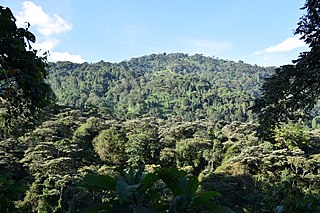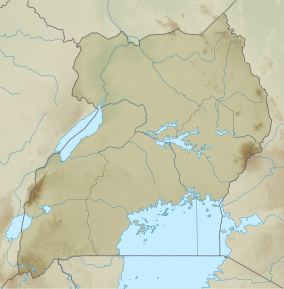Today, forest and woodland cover in Uganda stands at 49,000 km² or 24% of the total land area. Of these 9,242.08 km² is tropical rainforest, 350.60 km² are forest plantations and 39,741.02 km² is woodland. 30% of these areas are protected as national parks, wildlife reserves or central forest reserves.

Australia has many forests of importance due to significant features, despite being one of the driest continents. As of 2009, Australia has approximately 147 million hectares of native forest, which represents about 19% of Australia's land area. The majority of Australia's trees are hardwoods, typically eucalypts, rather than softwoods like pine. While softwoods dominate some native forests, their total area is judged insufficient to constitute a major forest type in Australia's National Forest Inventory. The Forests Australia website provides up-to-date information on Australia's forests. Detailed information on Australia's forests is available from Australia's State of the Forests Reports that are published every five years.
The Bugoma Forest is a protected tropical forest that is situated southwest of Hoima and northeast of Kyenjojo towns, and east of Lake Albert, in the Hoima district of western Uganda. It was gazetted in the 1932 and came under the mandate of the National Forestry Authority in 2003. But it was expanded in 1965, 1968 and 1998. Its surface area is given as between 41,144 hectares (411.44 km2) and 65,000 hectares (650 km2).
Nyabiku Central Forest Reserve is a gazetted forest reserve in Kibaale District, Uganda. It is located in the sub-counties of Mugarama and Nyamarunda, approximately 10 kilometers (6.2 mi) from Kibaale Town. The reserve covers an area of 3,400 hectares.

North Rwenzori Central Forest Reserve is a protected tropical forest situated between Bundibugyo District and Ntoroko District in Western Uganda. This Natural Forest Reserve is at the foothills of the Rwenzori Mountains east of the Democratic Republic of Congo.
Mafuga Central Forest Reserve is a protected area nestled within the landscapes of Rubanda district and Rukungiri district in Western Uganda. This forest reserve, managed by the National Forestry Authority (NFA), is renowned for its biodiversity, stunning mountain scenery, and ecological features. As a key component of Uganda's Central Forest Reserves system, Mafuga Central Forest Reserve plays a crucial role in conservation efforts and serves as a haven for numerous plant and animal species.
Rwengeye Central Forest Reserve is a protected tropical high forest in Kiryanga and Pacwa subcounties that are located in Kibaale District in Western Uganda. It covers an area of 329 hecatres (3.24 km²). It is operated by the National Forestry Authority (NFA). Its WDPA ID is 39999. It was declared a forest reserve in 1932.
Nyabyeya Central Forest Reserve is a forest reserve located in Masindi District, Western Uganda, Bujenje County, Budongo sub-county, and Nyabyeya parish in western Uganda. It is part of the extensive network of Central Forest Reserves managed by the National Forestry Authority (NFA) in Uganda. This forest reserve covers an area of about 358.06 hectares. Nyabyeya Forest Reserve was created to train students in forestry under the Nyabyeya Forestry College.
Ruzaire Central Forest Reserve is a protected high forest located in Kibaale district which is in the located within the Albertine Region. It covers an area of 1194.94 hectares. It is managed by the National Forestry Authority.
Mubuku Central Forest Reserve is a forest located in the Rwenzori Mountains region of Western Uganda, situated near the villages of Nyakalengija and Kilembe. The forest reserve covers a significant area and plays a vital role in the conservation of biodiversity and ecosystem services in the region.
Namatale Central Forest Reserve is a forest located in Mbale district, Uganda. It is a significant natural resource that plays a crucial role in the region's ecosystem and biodiversity conservation efforts.
Kapchorwa Central Forest Reserve is a forest reserve located in Kapchorwa district found in the eastern part of Uganda at the slopes of Mount Elgon. It is bordered by Mbale, Bulambuli, and Sironko in the south-west, Nakapiripit and Moroto in the north, and the republic of Kenya in the east. The area largely comprises the sabiny, pokot and the nandi communities of western Kenya. The 0.06 square kilometer forest reserve is located at an Altitude of 2,100 to 2,400 meters above sea level.
Rwoho Forest Reserve is a protected area located to the south of Bugamba Central Forest Reserve in Rwampara and Isingiro districts in south western Uganda. The reserve covers extensive high ground and numerous valleys, including the majority of the Kyezo valley's western watershed. Rwoho Forest Reserve has an area of 91 square kilometers and is maintained on behalf of the Government of Uganda by the National Forestry Authority (NFA) under the National Forestry Authority and Tree Planting Act 8/2003.
Lutoboka Central Forest Reserve is a protected area in Uganda's Eastern district of Kalangala. The 174 hectares Lutoboka Forest Reserve is located in Kalangala Town Council on Bugala Island.
Nakindiba Central Forest Reserve, a protect area located in Wakiso district, is a 142 hectares forest reserve with a boundary length of 7.2 kilometers. It is situated in Central Uganda and is protected by the National Forestry Authority under National Forest and Tree Planting Act.
Gangu Central Forest Reserve is a 1,054 hectares protected area located along the Kampala Masaka highway in Butambala District, South West of Kampala City in Central Uganda.
Nonve Central Forest Reserve is a 738 hectare forest reserve located in Kakiri Town Council, Wakiso District, Uganda. It is part of the Central Forest Reserves of Uganda, which are managed by the National Forestry Authority (NFA).
Mugomba Central Forest Reserve is a 100-hectare (247-acre) forest reserve located in Entebbe, Central Uganda. It is part of the Central Forest Reserves of Uganda, which are managed by the National Forestry Authority (NFA).
Kasato Central Forest Reserve is a protected tropical forest that is located in Kiryanga subcounty in Kagadi District in Western Uganda. It covers an area of 26.82 km2(2691 hectares) It managed by the National Forestry Authority. It was designated a reserve in 1965. Its WPDA ID is 39988.


